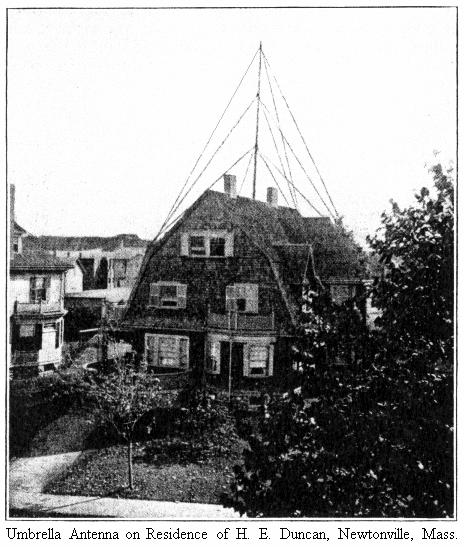The American Jeweler, November, 1912, pages 453-454:
TWO NEW WIRELESS TIME INSTALLATIONS.
_______
 The AMERICAN JEWELER has been receiving many inquiries in regard to wireless installations, by which the erector could receive standard time direct from Washington as soon as the signals start from the new tower in Alexandria. We show herewith two installations.
The AMERICAN JEWELER has been receiving many inquiries in regard to wireless installations, by which the erector could receive standard time direct from Washington as soon as the signals start from the new tower in Alexandria. We show herewith two installations.
The South Bend Watch Co. are installing a wireless station with tower 116 feet high, and over 1,200 feet of phosphor-bronze cable arranged in four strands as shown. This tower is 543 miles from Arlington, Va., and it is expected that the signals will be received without difficulty. The average person will wonder what lapse of time there will be between the sending of time at Washington and its receipt at the South Bend tower. Wireless waves travel at a speed which would enable them to make nine complete circuits of the globe in one second; therefore the elapse of time between the sending and receiving is so small that it is not worth reckoning with. Furthermore it is always the same.
The other illustration represents the residence of H. E. Duncan of the Waltham Watch Co., at Newtonville, Mass., and may be taken as a fair sample of the latest receiving station, privately installed in New England. It will be remembered in this connection that Mr. Duncan has been appointed consulting expert on wireless time by President Combs of the National Retail Jewelers' Association. The installation is what is known as the umbrella form of antennæ, and consists of three 10-foot sections of galvanized steel tubing, mounted on a porcelain insulator, on an 18-inch stand on the saddle board of the roof, which is 45 feet from the ground, thus making a total height of 76 feet 8 inches. From each dormer window runs a strand of tinned copper cable, one to the top, one to the top of the second section and one to the top of the first section. At the lower end these three gather into a five-inch ball insulator, which is wired to a turnbuckle to take up slack when necessary. From the turnbuckle another wire passes to an eye bolt in the dormer saddle board. As there are four windows, each with three strands, Mr. Duncan has a total of twelve strands, containing about 600 feet of wire. The lead-in wire can be traced on the front of the house from the top of the first 10-foot section to one side of the chimney, to a bracket with insulator at the front edge of the roof; then to the left, down to the top of the window casing, and thence down the window casing to a porcelain tube below the sill, and into the room. It returns through a similar tube to a 100-ampere capacity switch and down the front of the house with a No. 6 wire, which is carried in through the basement wall and attached to the water pipe back of the meter.
The switch and grounding, as indicated, are required by the insurance laws, and this installation has passed inspection. The wiring is very inconspicuous, so much so that it would not show in the photograph and had to be drawn in with a lead pencil on the photo from which our halftone was made. It will readily be seen, therefore, that there is no disfiguring of the house.
Mr. Duncan reports that he has received excellent results with the installation, having no trouble to hear Portsmouth, N. H., and Cape Cod in the middle of the day, and Norfolk and Savannah in the evening. He reports that two or three retail jewelers in the East will have a receiving set similar to that shown in Kansas City, and they expect to be in operation in about 30 days, receiving naval observatory time signals daily.


 The AMERICAN JEWELER has been receiving many inquiries in regard to wireless installations, by which the erector could receive standard time direct from Washington as soon as the signals start from the new tower in Alexandria. We show herewith two installations.
The AMERICAN JEWELER has been receiving many inquiries in regard to wireless installations, by which the erector could receive standard time direct from Washington as soon as the signals start from the new tower in Alexandria. We show herewith two installations.
